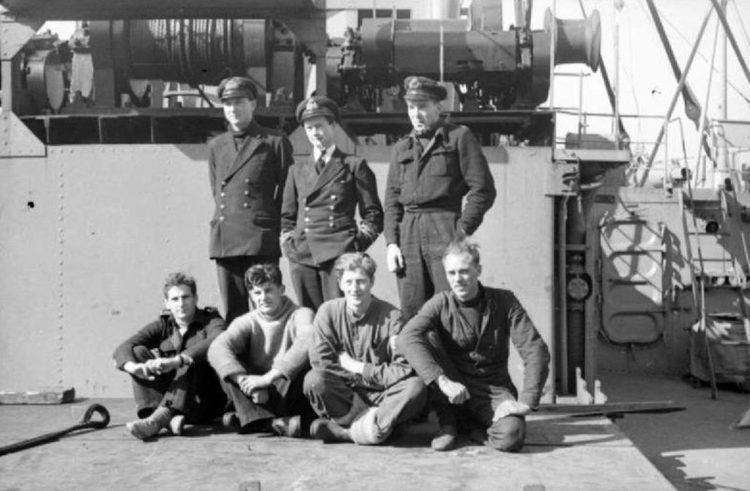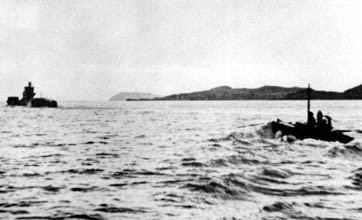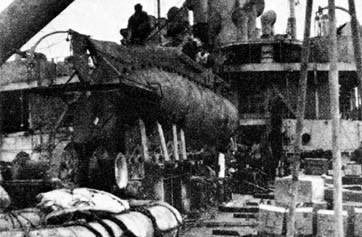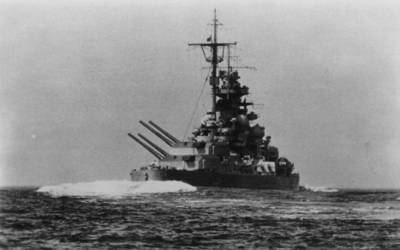9 killed, 6 prisoner 1 battleship damaged Result Allied success | Dates 20 Sep 1943 – 22 Sep 1943 | |
 | ||
Similar World War II, Operation Paravane, Operation Zitronella, Operation Anklet, Operation Catechism | ||
Operation Source was a series of attacks to neutralise the heavy German warships – Tirpitz, Scharnhorst and Lützow – based in northern Norway, using X-class midget submarines.
Contents
The attacks took place in September 1943 and succeeded in keeping Tirpitz out of action for at least six months.

The attack was masterminded and directed from HMS Varbel, located in Port Bannatyne on the Isle of Bute. Varbel (named after Commanders Varley and Bell, designers of the X-Craft prototype) was the on-shore headquarters for the 12th Submarine Flotilla (midget submarines). It had been a luxury 88-bedroom hotel (the Kyles Hydropathic Hotel) requisitioned by the Admiralty to serve as the Flotilla’s headquarters. All X-craft training, and preparation for X-craft attacks (including that on Tirpitz), was co-ordinated from Varbel.

Intelligence contributing to the attack on Tirpitz was collected and sent to the RN by the Norwegian resistance, especially brothers Torbjørn Johansen and Einar Johansen.

Attack

Six X-craft were used. X5, X6 and X7 were allocated the battleship Tirpitz, in Kåfjord. X9 and X10 were to attack the battleship Scharnhorst, also in Kåfjord. X8 was to attack the heavy cruiser Lützow in Langfjord.
The craft were towed to the area by conventional submarines (HMS Truculent (X6) Syrtis (X9), Sea Nymph (X8), Thrasher (X5), Stubborn (X7), and Sceptre (X10)) and manned by passage crews on the way. Close to the target, the operation crews would take over. X9, while commanded by S-Lt E Kearon of the passage crew and probably trimmed heavily by the bow in the heavy sea for the tow, was lost with all hands on the passage when her tow parted and she suffered an abrupt plunge due to her bow-down trim. X8 (passage crew commanded by Lt. Jack Smart) developed serious leaks in her side-mounted demolition charges, which had to be jettisoned; these exploded, leaving her so damaged she had to be scuttled. The remaining X-craft began their run in on 20 September and the attacks took place on 22 September 1943.
Scharnhorst was engaged in exercises at the time, and hence was not at her normal mooring, X10's attack was abandoned, although this was due to mechanical and navigation problems, and the submarine returned to rendezvous with her 'tug' submarine and was taken back to Scotland.
X5, commanded by Lieutenant Henty Henty-Creer, disappeared with her crew during Source. She is believed to have been sunk by a direct hit from one of Tirpitz's four-inch guns before the crew had a chance to place her charges. In 2004, a saddle charge identical to those used by the X-class was found on the bottom of Kåfjord, a short distance from the site of the attack. Although it has not been positively identified, it is believed to be from X5. An expedition jointly run by the late Carl Spencer (Britannic 2003) and Bill Smith (Bluebird Project) and the Royal Navy using the mine hunters HMS Quorn and HMS Blyth in 2006 mapped the north and south anchorages used by Tirpitz and was able to prove without doubt that this charge was well inside the net enclosure of the north anchorage and was therefore most likely to have come from X6. In June 2011 this device was detonated by the Royal Norwegian Navy.
X6 and X7 managed to drop their charges underneath Tirpitz, but were unable to make good their escape as they were observed and attacked. Both craft were abandoned and six crew survived to be captured.
Tirpitz was heavily damaged. While not in danger of sinking, she took on over 1,400 tons of water and suffered significant mechanical damage. The first mine exploded abreast of turret Caesar, and the second mine detonated 45 to 55 m (148 to 180 ft) off the port bow. A fuel oil tank was ruptured, shell plating was torn, a large indentation was formed in the bottom of the ship, and bulkheads in the double bottom buckled. Some 1,430 t (1,410 long tons) of water flooded the ship in fuel tanks and void spaces in the double bottom of the port side, which caused a list of one to two degrees, which was balanced by counter-flooding on the starboard side. The flooding damaged all of the turbo-generators in generator room No. 2, and all apart from one generator in generator room No. 1 were disabled by broken steam lines or severed power cables. Turret Dora was thrown from its bearings and could not be rotated; this was particularly significant, as there were no heavy-lift cranes in Norway powerful enough to lift the turret and place it back on its bearings. The ship's two Arado Ar 196 floatplanes were thrown by the explosive concussion and completely destroyed. Repairs were conducted by the repair ship Neumark; historians William Garzke and Robert Dulin remarked that the successful repair effort was "one of the most notable feats of naval engineering during the Second World War." Repairs lasted until 2 April 1944; full speed trials were scheduled for the following day in Altafjord.
For this action, the commanders of the craft, Lieutenant Donald Cameron (X6) and Lieutenant Basil Place (X7), were awarded the Victoria Cross, whilst Robert Aitken, Richard Haddon Kendall, and John Thornton Lorimer received the Distinguished Service Order and Edmund Goddard the Conspicuous Gallantry Medal. The commander of X8, John Elliott Smart was appointed a Member of the Order of the British Empire (MBE).
